Article
State of the specialty: Slumping pay, burnout drive retirement
Author(s):
More than one-fourth of urologists say they have specific plans to retire within the next 2 years. An ongoing drop in reimbursement, feeling burned out, and government mandates are the primary factors affecting when they will retire, according to the 13th annual Urology Times State of the Specialty survey.
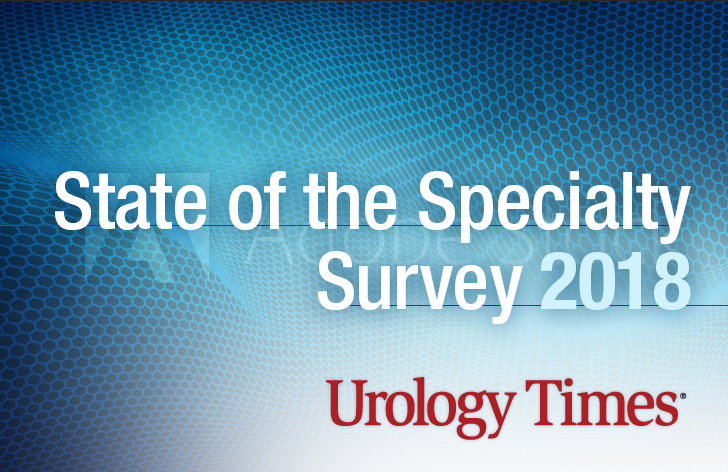
More than one-fourth of urologists say they have specific plans to retire within the next 2 years. An ongoing drop in reimbursement, feeling burned out, and government mandates are the primary factors affecting when they will retire, according to the 13th annual Urology Times State of the Specialty survey.
The results are in stark contrast to those of the survey 10 years ago, when urologists were asked whether their 5-year plan included retirement. Only 7% of 2008 survey respondents said retirement was in their plans; that number jumped to 28% in the 2013 survey.
As urologists test the waters of Medicare’s new Quality Payment Program (QPP), which rewards value and outcomes under the Merit-based Incentive Payment System (MIPS) and Advanced Alternative Payment Models (APMs), the survey found nearly 60% currently participate in MIPS and about 20% in APMs.
The State of the Specialty survey, launched in 2006, looks at the practice trends, attitudes, future plans, and often troubling concerns of practicing urologists. This year’s installment included new questions about MIPS and APM participation. Most respondents fall in the 45 to 59 (36%) or 60 to 65 age group (27%). Also see, “How the survey was conducted."
Retirement and other plans
The pressures and frustrations facing many physicians appear to hit urologists particularly hard, and the survey findings suggest that these factors may lead to early retirement. When asked about their retirement plans, 28% said they are actively considering retirement within 2 years, and 29% have made some non-specific plans to retire in 5 to 10 years. One-fourth had no plans to retire, and 8% are already retired.
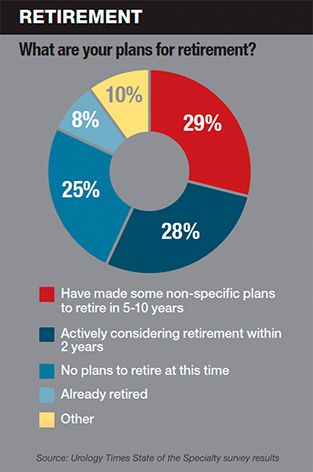
The common factors influencing respondents’ decision on when to retire are declining reimbursement (67%), burnout (64%), government influence in medicine (59%), and loss of interest/enjoyment (41%). Other factors were doctors’ workload (32%), not wanting to take the recertification/maintenance of certification exam (32%), and personal health/ability (31%).
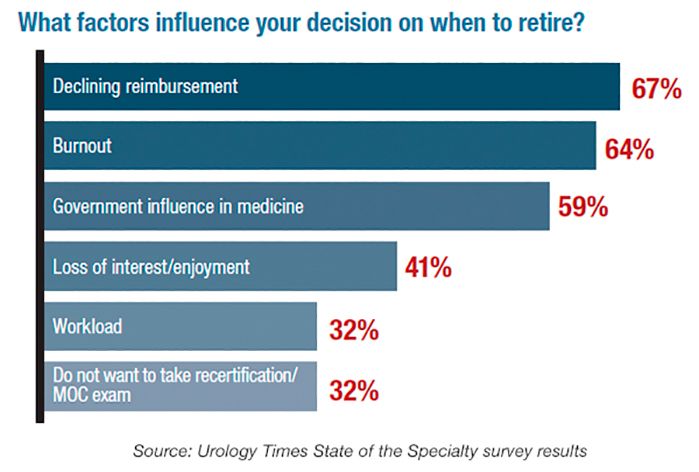
“Physicians are the least cared for members of the health care delivery system. Our time sacrifice is the least respected and least valued,” said one urologist in a fill-in response. “Actively searching for a way out of medicine,” another said. Said another: “Can’t wait to get out! [in] 2 months because this is killing me.”
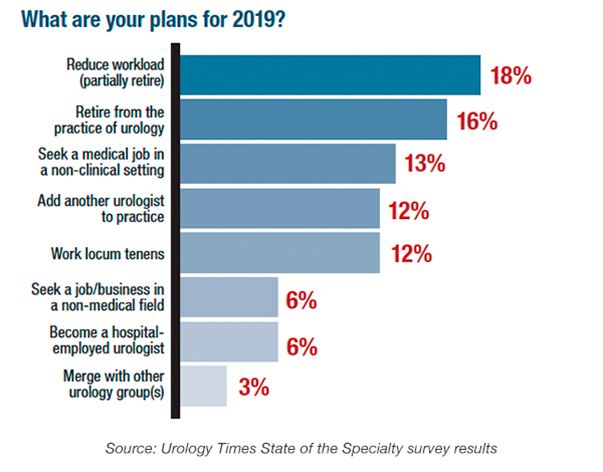
Some urologists have more immediate retirement plans. In a question about their plans for 2019, 16% said they will retire from the practice of urology, and another 18% plan to reduce their workload (partially retire). Other plans include looking for a medical job in a non-clinical setting (13%), adding another urologist to their practice, and working locum tenens (both 12%).
Next: Participation in MIPS, APMsParticipation in MIPS, APMs
Still in its infancy, the Centers for Medicare & Medicaid Services’ QPP essentially shifts physician reimbursement from fee for service to a system that rewards value of care. Fifty-eight percent of urologists say they participate in MIPS, one of two new avenues to reimbursement under the program. Only 19% participate in the second path, APMs, according to the survey.
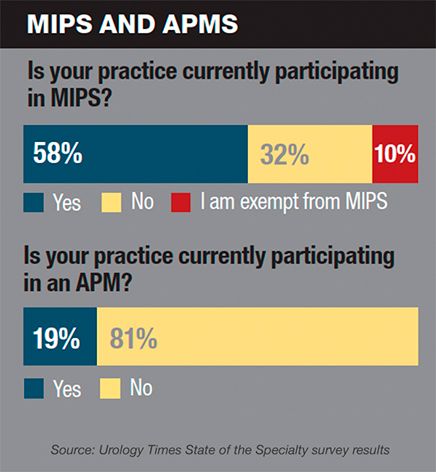
Most urologists lack a clear understanding of their choices regarding MIPS and APMs, with 46% reporting they understand the choices somewhat, 12% very well, and 42% not very well at all.
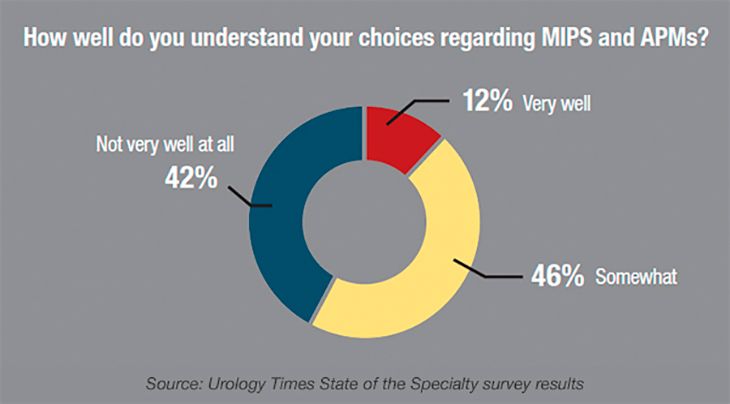
CMS has approved the AUA Quality Registry (AQUA Registry) as a Qualified Clinical Data Registry (QCDR), meaning it can be used by urologists to satisfy reporting requirements in MIPS. Just over one-third (37%) of urologists report current participation in in the AQUA Registry or another QCDR, and 7% said they plan to participate in the AQUA Registry or another QCDR within the next year. Thirty-nine percent were not sure if they would do so.
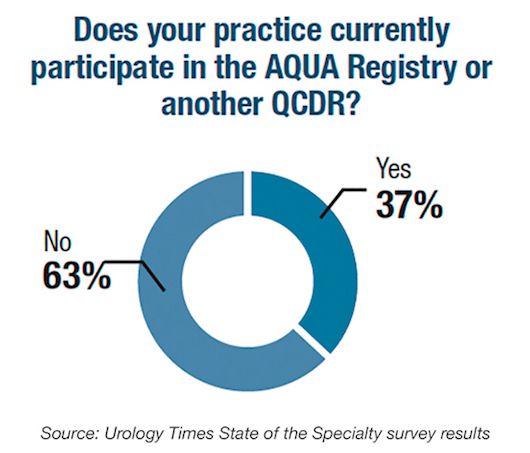
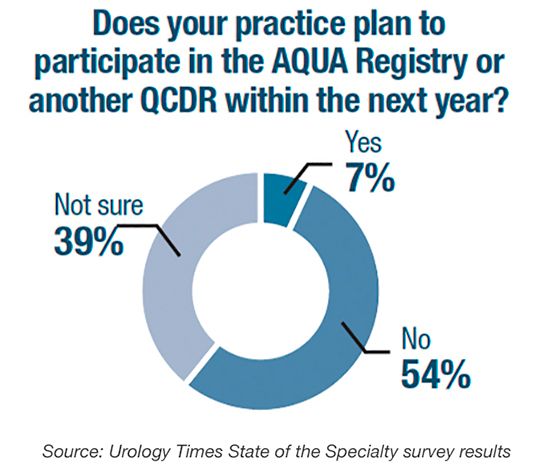
The most common method used by urology practices for reporting MIPS measures is to report directly to CMS via electronic health record software (61%). Less common methods are a third-party vendor (21%) and the AQUA Registry or other QCDR (18%). Twenty percent of practices have had to appeal their MIPS score at least once, and of those, 18% were successful.
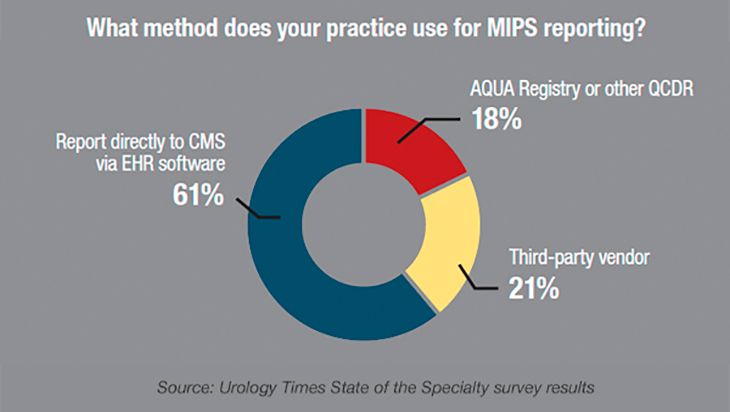
Of note, the survey was developed prior to the AUA’s announcement that it now offers a MIPS Manual Entry Webtool, a reporting option for providers who are unable to report electronically through the AQUA Registry. The webtool allows providers to report on both QPP and non-QPP urology-specific measures, which are most relevant to urologic providers, according to the AUA. For more information, visit bit.ly/AUAWebtool.
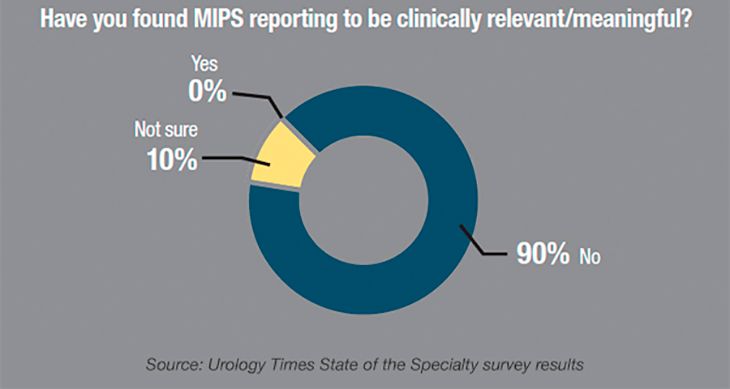
Responses to survey questions about the time and money urologists spend tracking and reporting MIPS measures were not usable due to a low response rate. However, fill-in responses indicate that providers are spending considerable time reporting measures. One respondent described the number of hours spent on reporting as “endless,” and a second said it was “too much.”
Asked if they found MIPS reporting to be clinically relevant or meaningful, 90% of urologists said no and 10% were unsure. None said yes.
Next: Satisfaction and burnoutSatisfaction and burnout
Urologists tend are lukewarm about their choice of a career in medicine (half said they would make this career choice if they were starting out today), but high satisfaction with their choice of specialty (86% would choose to practice urology if starting out). A total of 88% agree or strongly agree with the statement, “I used to enjoy being a physician more, but it’s less lucrative/more stressful now.”
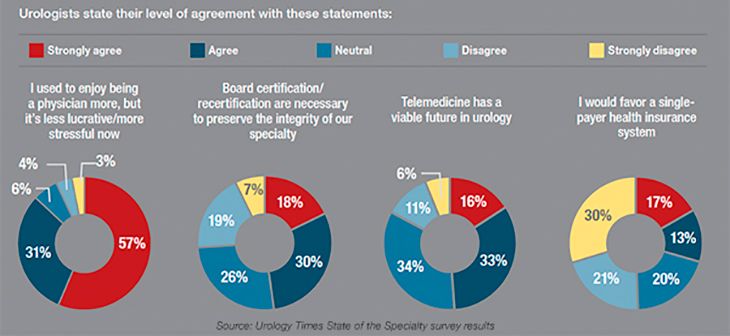
Given a list of possible concerns, urologists’ rankings indicate that it is the business and administrative aspects of practice, rather than patient care, that they find most burdensome. As in past surveys, their most pressing concerns are increasing government regulations (94%), declining reimbursement (93%), prior authorization requirements (92%), and increasing overhead/overhead management (89%).
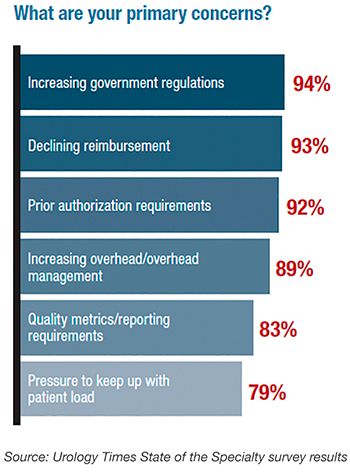
One-third report being burned out, and another 30% say they’re not currently burned out but are heading in that direction. Use of electronic health records was the leading factor leading to feelings of burnout (68% said it “very much” contributes to burnout), followed by falling revenue and/or rising overhead (65%), prior authorizations (51%), workload (50%), and unappreciative/unreasonable patients (44%).
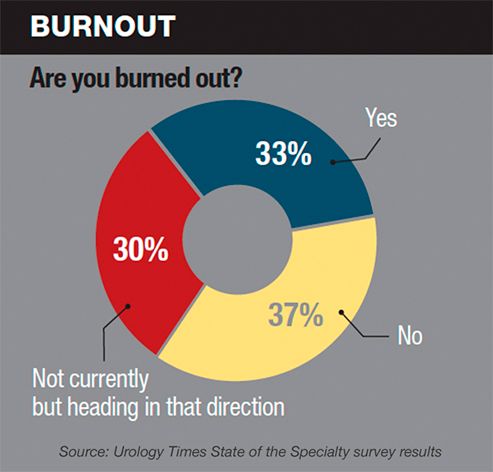
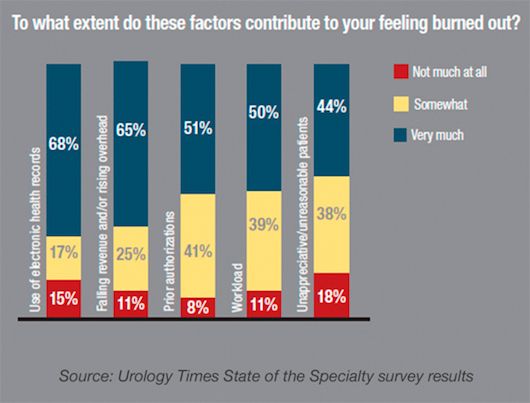
Asked for other contributors to burnout, one urologist cited “Major decisions being made in health care delivery without physician input.” Another responded: “Too much premium dollars going to pharmaceutical companies and others profiting inappropriately.”
Continue to the next page for more.
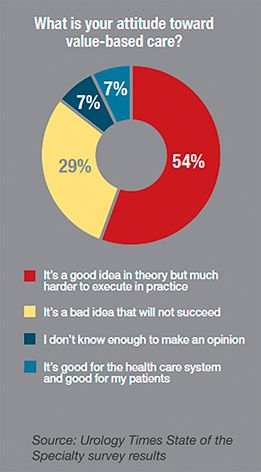
How the survey was conducted
The 2018 Urology Times State of the Specialty survey was conducted via email in early October 2018. All survey recipients were subscribers to Urology Times, and all were required to report they were a urologist or urology resident before responding to the survey. A total of 158 responses were received. The majority of respondents were age 45 to 59 (36%) or 60 to 65 (27%), and 58% were in private practice. Those who responded were eligible to enter a drawing to win one of three $100 Visa gift cards.
Newsletter
Stay current with the latest urology news and practice-changing insights — sign up now for the essential updates every urologist needs.















